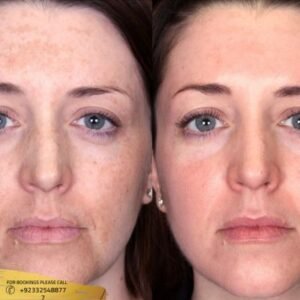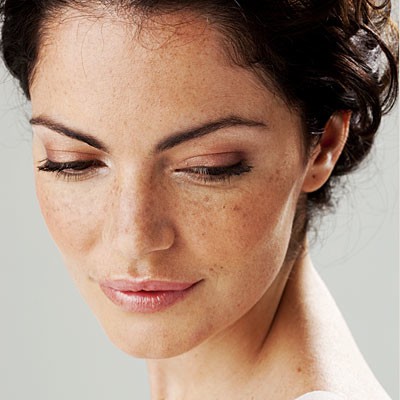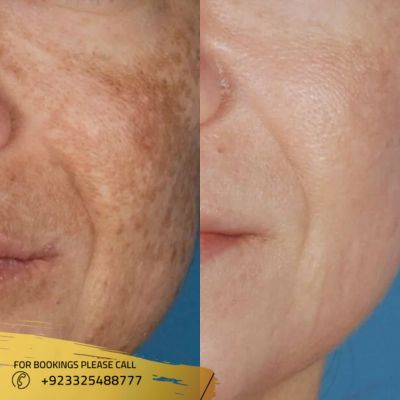
Don’t you want to show a clear and spotless face to the world? Sometimes people may get grey or brown patches on the skin. The face is primarily affected by this condition. Skin becomes patchy and the color of that area becomes darker than the rest of the body. Particularly in regions with considerable sun exposure, those with a light brown complexion to deeper skin tones are more likely to get melasma. Melasma is more common in women and can show up as brown patches on the face, notably on the cheeks, nasal bridge, and forehead. Various clinics are offering Melasma Treatment in Islamabad. But Royal Cosmetic Surgery Clinic is offering you the treatment at the most affordable rate.
Body Parts Affected by Melasma:
The parts of the face where melasma most frequently manifests are:
- The bridge of the nose
- The top of
- Your cheeks
- The upper lip
- Its chin
Other parts of the body, particularly those that receive a lot of sunshine, may also develop melasma. These locations could consist of:
- Arms
- Forearms
- Head
- Shoulder
Causes of Melasma:
- Solar exposure: Melasma might develop if you are exposed to UV radiation frequently.
- Skin tone: People with light brown skin tones are more likely to get melasma, especially if they dwell in regions with extensive sun exposure.
- Gender: About 9 times more women than men are affected with melasma.
- Pregnancy: Melasma affects 15 to 50 percent of pregnant women, making it more prevalent during this time. Hormones related to pregnancy may be to blame.
- Genetics: Close relatives of up to 50% of melasma sufferers report having the disease as well.
Triggers for Melasma:
- Birth control medications, hormone therapy, or hormonal changes that occur during pregnancy (chloasma)
- A person’s skin may become irritated by some skin care products.
- A few drugs, such as blood pressure medicines, some antibiotics, retinoids, anti-seizure medications, and drugs that make the skin more sensitive to sunlight.
Diagnosis of Melasma:
- A dermatologist can frequently identify melasma by carefully examining your face and neck.
- Your dermatologist might employ a specialized tool, such as a Wood’s lamp or dermatoscope, to obtain a close-up view.
- These tools, which are put on (or close to) your skin, allow your dermatologist to assess how far into your skin’s layers the darker pigment has penetrated.
- If you’re trying to treat melasma, having this knowledge is really beneficial. This article will explain to you all about melasma treatment.
Treatment of Melasma:
Melasma cannot be treated by monotherapy. A combination of different measures is necessary for its treatment.
General Measures:
- A broad-brimmed hat needs to be used.
- broad-spectrum very high protection factor (SPF50+), and year-round, lifetime sun protection Iron oxide-containing sunscreen.
- If at all feasible, stop using hormonal contraception.
Topical Therapy:
Combining hydroquinone, tretinoin, and a moderate intensity topical steroid (skin lightening cream) has proven to be the most effective recipe. It is said to clear up or improve 60–80 percent of skin conditions.
Other topical medications that have been used singly or, more frequently, in combination include:
- Azelaic acid
- Kojic acid
- Cysteamine cream
- Ascorbic acid
- Methimazole
- Tranexamic acid
- Glutathione
- Soybean extract.
Certain other medications are also being used.
Oral Treatment:
The synthesis of prostaglandin and other elements related to melasma is inhibited by tranexamic acid because it prevents the conversion of plasminogen to plasmin. Trials of more novel oral medications are ongoing.
- Melasma is commonly treated with hydroquinone. It serves to even out the skin tone when applied to the skin. Products that you can buy without a prescription no longer include hydroquinone.
- Combining retinol with a moderate corticosteroid can balance out skin tone because it contains both a retinoid and an anti-inflammatory.
- Tretinoin (a retinoid), a corticosteroid to relieve inflammation, and hydroquinone to even out your skin tone are all present in the triple combo lotion.
- Other drugs: Your dermatologist may recommend a drug that is less harsh on your skin, such as vitamin C, kojic acid, or azelaic acid.
Techniques for Melasma Treatment:
However, there is a chance that they could exacerbate melasma or result in post-inflammatory hyperpigmentation if taken carelessly. Tyrosinase inhibitors, such as hydroquinone, should be used in the patient’s pretreatment. In the event that topical treatments are ineffective, a dermatologist might advise:
- Microdermabrasion: Cosmetic surgery includes microdermabrasion. With the aid of a tiny hand-held gadget, a skincare expert removes the epidermis.
- Synthetic peel: The synthesis of prostaglandin and other elements related to melasma is inhibited by tranexamic acid because it prevents the conversion of plasminogen to plasmin.
- Trials of more novel oral medications are ongoing.
- laser therapy: Medical procedures called laser therapy make use of concentrated light. Light from a laser—which is short for light amplification by stimulated emission of radiation—is tuned to particular wavelengths, unlike light from most other sources.
- light treatment: In order to improve the skin, LED (light-emitting diode) light therapy penetrates the skin’s layers without causing any harm.
- Dermabrasion: The outer layers of skin are sanded off during dermabrasion, a skin-resurfacing technique. The treated skin will seem crimson and puffy right away after dermabrasion. Usually, new skin has a smoother texture.
Some of these treatment approaches can have negative side effects or lead to new skin issues. It is best to discuss potential hazards with a physician or dermatologist.
If someone has previously experienced melasma, they can strive to avoid triggers by:
- reducing exposure to the sun
- by putting on a cap outside
- sun protection
Post-treatment Care:
- Utilize all of the topical drugs that your dermatologist has prescribed.
- Maintain moisture in your skin to prevent flakiness.
- After the treatment, avoid exposing the treated regions to the sun for at least a few months.
- Avoid excessive facial touching and picking at your skin.
- Every four hours, apply ice packs to reduce the swelling and redness.
- Massage the treatment area sparingly.
Results:
It typically takes between three and twelve months to notice effects when you adhere to your treatment regimen. If you’ve had melasma for a long time, it can take longer. Self-care is frequently advised by dermatologists to enhance patient outcomes.



Cost of Melasma Treatment:
The cost of Melasma Treatment in Islamabad, Pakistan starts from PKR 10,000 to PKR 15,000 for one session. Depending on the course of therapy that you choose, the cost of melasma treatment might vary. Most insurance companies won’t pay for the drugs or procedures used to treat melasma because they don’t consider the treatment to be medically essential.
Dermabrasion and microdermabrasion are the most efficient treatments for melasma.
Laser resurfacing may be performed in extreme situations.
Why Choose Us for Melasma Treatment:
The team at Royal Cosmetic Surgery is highly specialized and professional. You will always feel at home while visiting our clinic. Dr. Ayusha Khan is highly qualified and a specialist in her field. So if you are thinking of getting Melasma Treatment in Islamabad then you must book a free first consultation with us. Call us on the given number or fill out the form below.









